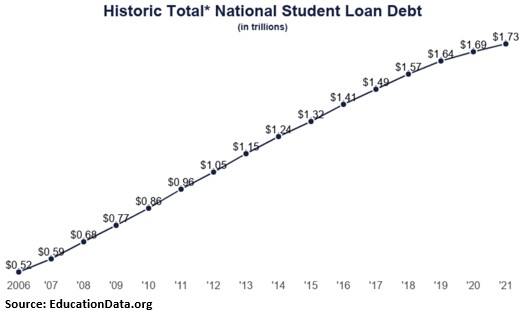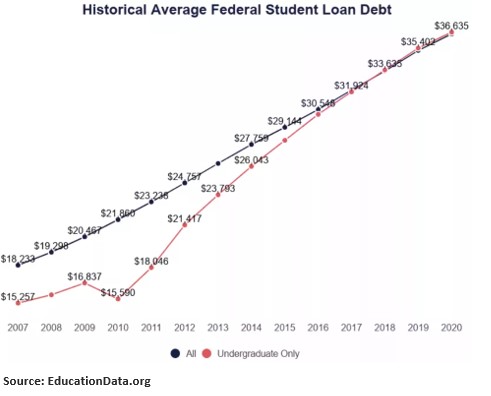I last wrote about President Biden’s student loan forgiveness plans on September 6 in Forecasts & Trends. In that column, I argued Mr. Biden’s plan to forgive $10,000 to $20,000 of student loan debt was a bad idea for several reasons. But what I emphasized most was the fact that the president wanted to limit student debt repayments to no more than 5% of discretionary income, and after 10 years of making payments, any remaining student debt would be completely forgiven, instead of 20 years previously.
Fortunately, the courts put Biden’s very ambitious student loan debt repayments/forgiveness on hold, arguing the president has no such constitutional authority. This legal battle is likely headed to the Supreme Court. That’s the good news. The bad news is the Biden administration continues to monkey with the student loan mess, and his latest proposed moves would make an already bad situation even worse. That’s what we’ll talk about today.
In the lead-up to the midterm elections, President Joe Biden often described his plan to cancel some federal student-loan debts as a “game changer.” In one sense, this policy has indeed proved transformative – but by making a bad system worse.
Biden’s plan provides $10,000 in relief to individual borrowers with annual incomes of $125,000 a year or less, or $250,000 for married couples. It also provides forgiveness up to $20,000 per individual borrower who received the money through Pell Grants.
Since August, the government has approved 16 million applications for loan forgiveness – more than one-third of the total number of borrowers — but legal challenges have put the program on hold. Last month, a federal appeals court ruled in favor of six Republican-led states that opposed granting loan forgiveness while the litigation is ongoing. The White House has asked the Supreme Court to take up the case, which means the issue is likely to remain unresolved for months.
With this plan stalled, the administration has resorted to a fallback: extending a freeze on all federal student loan payments, which has been in place since the start of the pandemic. The decision reverses Biden’s previous insistence that borrowers would have to resume paying off their loans on January 1. While a freeze on payments is not the same as forgiving the debt, it has largely the same effect as long as the freeze stays in place.
It’s difficult to overstate the folly of this decision. The student-loan moratorium has been extended eight times already; Biden now says the freeze will last until at least next June. While this may cheer borrowers who’ve grown accustomed to forbearance, the rest of the country will bear the costs.
The moratorium has already deprived the government of $155 billion in expected revenue; freezing payments through the middle of 2023 will cost taxpayers tens of billions more. Because much student-loan debt is held by high earners and those who borrowed to pay for graduate degrees, the extension amounts to a subsidy for the affluent at the expense of Americans without a college degree.
Freezing student-loan payments made some sense as a form of temporary relief during the early months of the pandemic, but there’s no such justification now, with unemployment back to pre-pandemic levels. Allowing borrowers to forgo monthly payments also belies the administration’s supposed commitment to fight inflation, since they’re likely to spend the money they would otherwise have applied to their loans.
Meanwhile, those who’ve continued to pay down their balances during the freeze have reason to conclude that they’ve been duped.
Given these obvious harms, the administration’s motives seem almost entirely political. Having dangled widescale loan forgiveness to rally support among young voters before the midterm elections, Biden risks a backlash if he requires borrowers to resume making payments before any of the promised debt relief has materialized.
In the event that the courts strike down the loan-forgiveness plan, progressive advocates are sure to demand that the repayment freeze be extended indefinitely. This would encourage borrowers of all income levels to take out bigger loans, remove incentives on colleges to hold down costs and boost overall debt levels even more – effectively, the worst of all worlds.
The administration could’ve avoided this mess by ignoring progressive advocates and instead working with Congress to fix the existing student loan system. Low-income borrowers should be automatically enrolled in a simplified income-based repayment plan to ensure that they pay what they can afford.
In addition. the amount that students can borrow for graduate school should be limited. Measures to gather data on students’ career outcomes should be strengthened, and institutions should be held accountable for saddling graduates with high levels of debt they’ll never repay.
Any of these reforms would produce a fairer and more rational system for borrowers and taxpayers alike. Instead, Biden has decided to double down on an ever more costly mistake. Need I say more?



The biggest winners for the government’s student loan fiasco are the universities. Student loans should be based on a return on investment for whatever degree a student acquires. A failed return should be charged back to the seller of that loan, i.e. the university who peddled a bad product. When the universities have to repay the government for poor outcomes of their products they may more quickly QC their applications and perhaps even layoff a few administrators.